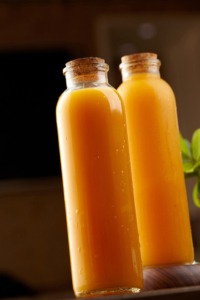Organic Acids
Sea buckthorn berries contain organic acids, mainly malic acid and quinic acid, which together compose approximately 90% of all fruit acids of different origins. Large variations exist between the concentrations of sea buckthorn acids of different origins. The subspecies of Hippophaë rhamnoides L. from Russia showed relatively low concentrations of total acidity (2.1–3.2 g/100 mL), the Finnish were at an intermediate level with a range between 4.2 and 6.5 g/100 mL, while Chinese showed the highest concentrations of organic acids, with values between 3.5 and 9.1 g/100 mL. Depending on fruits’origin, malic acid contents in sea buckthorn juice vary between 11 and 60 g/L, quinic acid content between 7 and 49 g/L, 0.2–0.6% of all acids succinic acid, 0.04–0.3% of all acids citric acid and 0.013–0.014% of all acids tartaric acid.
Mineral Elements
 As a good source of essential mineral elements, the ash content in sea buckthorn berries is 4500 mg/kg. Because of the high content of water (82.6%), the ash content corresponds to 2.59% on dry weight basis.
As a good source of essential mineral elements, the ash content in sea buckthorn berries is 4500 mg/kg. Because of the high content of water (82.6%), the ash content corresponds to 2.59% on dry weight basis.
There are many elements and trace elements in sea buckthorn. Potassium is the most abundant of all the trace elements identified. The contents of four main metals and phosphorus decrease in order potassium > calcium > phosphorus > magnesium ≈ sodium. However, the published data concerning sea buckthorn samples originated from different countries are quite inconsistent in the reported concentrations of individual elements. It is natural that the content of an element in plant material depends on many factors including variety or species, the part of plant, an area of cultivation, a composition of soil, a degree of maturity, etc. All these factors manifest themselves also in the case of sea buckthorn samples of different origin.
Comparing the trace element contents in other berries such as raspberries, blueberries and black currant berries, sea buckthorn contains less manganese and iron. Although the total iron concentration in sea buckthorn is low, its biological accessibility could be the best because of the positive effect of high ascorbic acid content on iron absorption. In addition, the high selenium content is known for its antioxidant properties and role in boosting immunity and fertility.
As far as the toxic elements are concerned, their content in sea buckthorn is very low. Data in our previous report of analyses of sea buckthorn berries and juice belonging to Hippophaë rhamnoides L. showed low contents of arsenic, lead, and cadmium, significantly below the maximum amount allowed by regulations in effect.

Leave A Comment